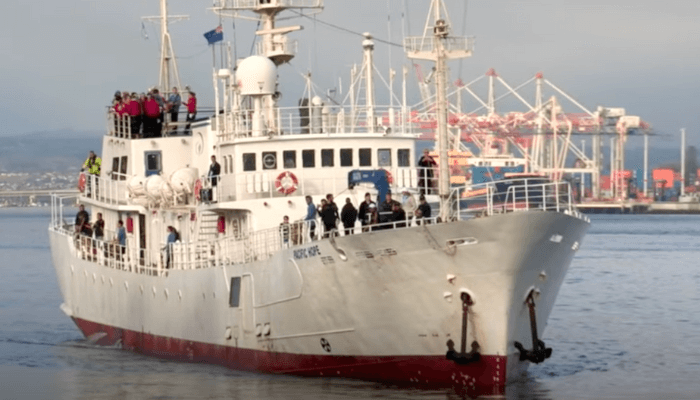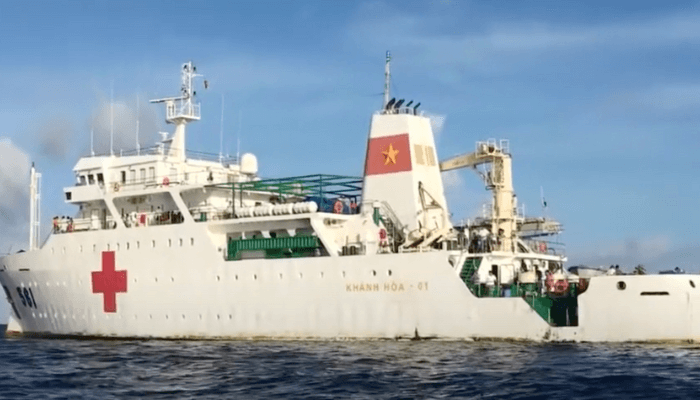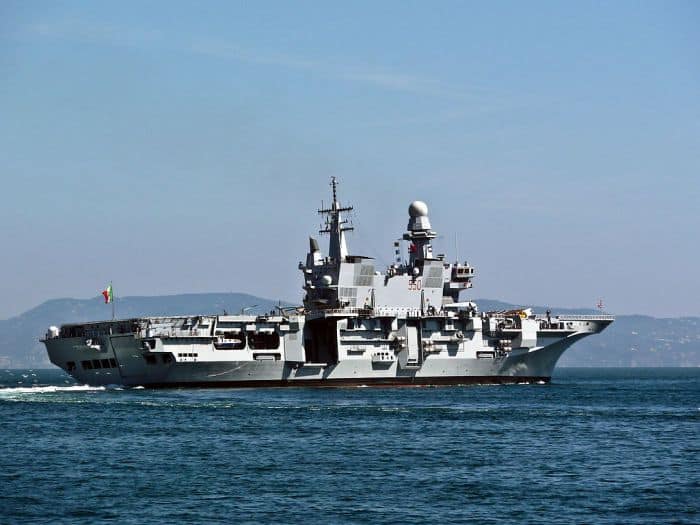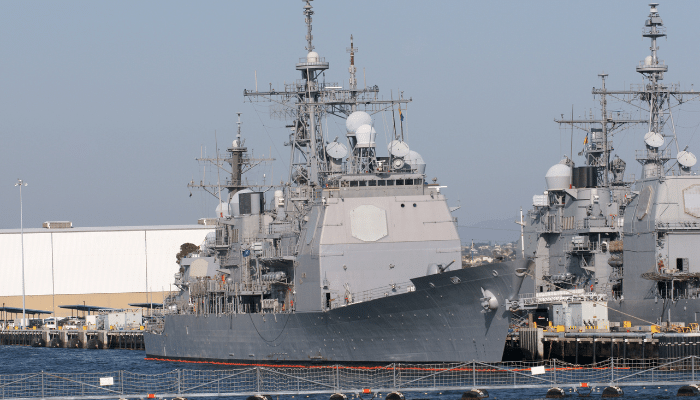10 Largest Hospital Ships In The World
What is a hospital ship?
A hospital ship is designed to be a floating hospital on the ocean or seas to offer medical treatment spanning from minor to major surgeries, prescribing medication, etc.
One may wonder when they were even invented and why. However, they are not a modern phenomenon, as they have existed since ancient times.
The navy of Athens had a ship called Therapia, and even the Roman Navy had a similar ship called Aesculapius. Their names and descriptions indicate they were hospital ships, providing comfort to the wounded and sick.
What is the need for Hospital Ships in the world?
Today, most hospital ships are operated by a country’s navy and used during peacetime and even during war, global emergencies, natural disasters, etc.
In developing nations, there is a shortage of medical providers, medical tools, and medicines needed for surgery and infrastructure. Secondly, some poor communities live in far-flung regions away from hospitals on the land and near the coast or shores. They lack access to basic medical care and attention and suffer since they lack money to get treatment.
In all these scenarios, hospital ships come to their rescue as they visit such people and give them timely treatment, almost free of cost.
Use of Hospital Ships during the World War Period
In the 19th century, old and obsolete warships were used as hospital ships to treat the soldiers. Hospital ships were used on a huge scale during the World War Period when several passenger liners, such as RMS Aquitania and HMHS Britannic, were converted to be used as floating hospitals.
The hospital ships look different from other ships as they are painted in white and carry a white flag with a red cross. Even their interiors, utensils and furniture are designed to give the feel that one is in a hospital on land.
The 2nd Geneva Convention prohibits any military attacks on these vessels; however, during World Wars, even hospital ships were targeted. For instance, Canada’s SS Letitia (i) and HMHS Llandovery Castle were sunk by a German boat, resulting in several deaths despite the status of the ships.
Let us explore the 10 largest hospital ships in this article.
1. MV Global Mercy
The world’s biggest civilian hospital ship, MV Global Mercy, was built as a floating medical centre for Mercy Ships. This humanitarian organisation operates the largest non-governmental hospital ships in the world.
It was constructed by CSSC at Tianjin Xingang Shipyard in Tianjin, China, and completed in 2021. The following year, she sailed to Rotterdam for a 2-week stopover, where it was revealed to the world for the first time. It made its maiden voyage soon after to Africa, where it was joined by another hospital ship called Africa Mercy. Global Mercy then began functioning as a floating training facility in Dakar, Senegal.

Coming to its specifications, it is 174 m long and weighs 37,000 tonnes with 12 decks. The hospital is on decks 3 and 4 and has supply services, 6 operating theatres, 102 beds, 7 ICU beds and 90 sef-care beds.
It also has classrooms and simulator rooms to train medical professionals. There are meeting rooms, working spaces and accommodation for 612 people. There is a K-12 academy for children of the volunteers serving on the ship.
2. MV Africa Mercy
Africa Mercy is the second largest hospital ship in the Mercy Ships’ fleet and the world. It is 152 m long and 23.7 m wide with a 6 m draught. It was converted from a rail ferry called MS Droning Ingrid in 2007.
It has 8 decks, the lower ones of which are a hospital with 5 operating theatres, an ICU, a CT Scanner, labs, a recovery area for around 82 patients, and an ophthalmology unit.
The upper decks have living spaces for 484 crew. There are 126 cabins, a school for all age groups, a library, a laundry area, a restaurant, supermarkets, gyms, shops and even a Starbucks Cafe.

The vessel provides surgical care onboard and even undertakes land-based operations and mental health campaigns for the terminally ill. It has 28 vehicles that travel with the ship for its shore-based activities.
The operating rooms have everything required for specific surgeries required by people of a country that this ship visits.
Since it visits the poorest countries, ailments like hernias, tumours, burns, cataracts, childbirth injuries, etc, can become serious, and the people suffering from them are shunned from their communities. Hence, the doctors onboard treat them and gift them their normal lives back.
3. USNS Mercy
USNS Mercy is the lead ship of her class and is in non-commissioned service with the U.S Navy. There are no offensive weapons onboard this hospital ship, but it carries defensive ones.
National Steel and Shipbuilding Company in San Diego, California, built it as a San Clemente-Class Oil Tanker called SS Worth in 1976. However, her name was changed in 1984 when she was made into a hospital ship and launched the next year.
USNS Mercy strives to offer medical and surgical operations to support Marine Corps Air and Ground Task Forces, the naval amphibious task forces, Army and Air Force units, and battle forces.
She can also give surgical services to government agencies in times of disaster and offer humanitarian relief and function during peacetime military operations.
The ship has 1000 patient beds and is homeported in San Diego. It has many departments, such as radiology, physical therapy and burn care, dental unit, optometry, angiography, blood bank, morgue, labs and 2 oxygen-producing plants.
4. Esperanza Del Mar
A medical or hospital ship constructed by the Gijon Yard of the Izar Group in 2001, Esperanza Del Mar belonged to Spain. It was built to function in unpleasant weather conditions to offer medical assistance when required.

It has comfortable accommodation space for 41 crew members and can easily handle 17 patients and 30 people who face accidents while at sea.
The ship can engage in salvage operations and assist other ships in distress. It also has a scientific research container shipping ability and can also accommodate logistics support cargo in case of natural disasters in its hold. It has a helideck and a helicopter refuelling facility. The ship has special design features like manoeuvrability and low levels of noise.
5. Daishan Dao
The lead ship and the only ship in her class, this Type 920 hospital ship belongs to the Chinese Navy. It was built by Guangzhou Shipyard International Company Limited and launched in 2007 to give China a means to offer better and quicker humanitarian assistance in terms of global emergencies. Some argue that it allows China to expand its Blue Water capabilities.

It was commissioned in 2008, and two years later, it embarked on a historic mission to the Gulf of Aden with 428 officers and 100 medical professionals. She visited Djibouti, Kenya, Bangladesh, Seychelles, Tanzania and Kenya and offered medical treatment to the locals.
The ship, also called Peace Ark, went to Djibouti, Gabon, Sierra Leone, Congo, Mozambique, Angola and Tanzania and treated thousands of people.
The ship has 300 beds, 8 operation theatres, and 20 ICU beds, enabling doctors to perform about 40 surgeries daily. Traditional Chinese medicine is also available onboard this ship. She is equipped with a remote communications and networking system that allows teleconferencing with specialists and doctors onboard the ship.
6. Irtysh
This Ob-class hospital ship of the Russian Navy was constructed to offer medical care. Part of the Pacific Fleet, it has a civilian crew but can carry uniformed naval medical personnel.
Its goal is to receive, distribute, and offer medical help to the injured, sick and wounded in times of peace or even during hostile situations. It also undertakes evacuation missions from other ships.

The Irtysh was ordered in 1981 and was constructed by Adolf Barsky, Szczecin. She was launched in 1989 and commissioned in 1990.
The 145.7 m ship with a 6.2 m draft is equipped with all medical and surgical equipment. She was modernised in 2016 and again in 2017 to add telemedicine equipment.
The ship can carry 300-450 patients and 207 crew members. She can sail at a speed of 19 knots, and her homeport is Vladivostok.
7. M/V Pacific Hope
Pacific Hope is a medical relief ship that has a dental clinic and a general medical facility and can accommodate around 60 people. It was constructed in 1983, is 54.1 m long, and has a 20,0000 nautical mile range.
It was earlier operated by Marine Reach New Zealand and has completed its outreaches in Vanuatu and Fiji, after which it headed to the Caribbean in 2018 to help with hurricane relief.

Under the ambit of Marine Reach Global, this ship continues to make its impact in taking medical help to the needy across the globe and restoring hope to the poor communities that need it the most.
Marine Reach Global is a non-governmental organisation that aims to show the love of Christ and promote his Gospel through medical help, educational outreach, youth development, training programs, repairs, construction building, distribution of supplies and the Bible. It oversees the operations and hopes to achieve its mission through the work of the ships MV Pacific Hope and the YWAM Barbados.
8. KRI dr. Radjiman Wedyodiningrat (992)
The 2nd ship of the Indonesian Navy’s Sudirohusodo-class hospital ships is named after a respected national figure, Rajiman Wediodiningrat, a physician and a founding figure of Indonesia.
Its construction began on 10th September 2020, and its keel was laid a year later on 21st January 2021. She was christened and launched on August 15, 2022. Finally, the ship was commissioned in January 2023.

The ship is preparing for a possible deployment to aid the people of Palestine after the 2023 Israel-Hamas conflict and the bombing of Gaza by Israel.
KRI dr Radjiman Wedyodiningrat (992) has a radiology, surgical, and postoperative room. It also has an isolation area and treatment rooms for 46 people. There is also a baby room, an emergency room, a lab and a morgue.
The ship is 124 m long and weighs 7300 tonnes. It has a speed of over 18 knots and can accommodate 163 crew members, 18 heli pilots, 66 medical staff, 158 patients and 280 volunteers. It has three onboard helicopters and two ambulance boats.
9. Papa Francisco
This ship was made to provide medical assistance to over 1000 indigenous communities living along the river in the northern part of Brazil’s Amazon region. It is named after Pope Francis and was constructed by the Industria Naval do Ceara shipyard.
This hospital ship was constructed with the financial support of Para’s government. It is 32 m long and has a 6 m beam with a speed of 7 knots. It has dental rooms, an operating theatre, a vaccination room, an ophthalmologic room, a treatment room and an infirmary with patient beds.

It can accommodate 30 people and also has a galley, a mess area, a library and a laundry area. There are 20 crew members and 20 medical staff who serve on the vessel as volunteers. The ship undertakes a 7 to 10-day voyage in which it visits as many riverside communities as it can before coming back to its homeport of Obidos on the Amazon River.
It was delivered in 2019 and since then has operated along the Amazon River, except for brief pauses during the Covid-19 in Brazil in 2020. Apart from providing medical care to riverside communities, it also delivers humanitarian aid, food and hygiene kits to coastal communities with barely any access to the basic necessities.
10. Khanh Hoa 01
Also referred to as HQ-561, this hospital ship is said to be one of the most modern and advanced ships of its kind in the Southeast Asia. It is operated by healthcare professionals and doctors who provide medical care to residents, military personnel and fishermen in the Truong Sa or the Spratly Archipelago.
This ship has an operating theatre and often operates amidst strong winds and waves. Per Senior Lieutenant Ta Trung Thanh, the vessel’s political commissar, all crew members have been trained to perform basic first aid.

The ship has transported medicine and carried out emergency treatments for thousands of military personnel, fishermen and locals in the region since 2012.
Khanh Hoa 01 spends 2 months every 2 years serving DK1 platforms and the Spratly Archipelago. It also takes military personnel and other people to visit or work on the islands and even deliver water and food to those inhabiting the islands.
This ship represented the Navy of Vietnam at the Komodo exercise, which included 18 nations, of which 10 were part of ASEAN. During this naval aid and disaster relief exercise, three surgeries were done onboard the ship apart from examining thousands of Indonesians.
Conclusion
The hospital ships operated by navies of different countries, as well as several non-governmental organisations, are a testament to the commitment of these entities to offering medical care and humanitarian aid to the most needy across the world.
These floating hospitals are marvels of engineering and innovation. They are equipped with the most advanced equipment and need a lot of energy to function daily. Above all, they are the epitome of the dedication and compassion of healthcare workers, many of whom function on these ships voluntarily.
Hospital Ships can come in handy during emergencies, man-made and natural disasters, wars, etc and can even be used to house people for a short time in case such a situation arises.
The fact that there are so many hospital ships in the world which operate round the clock so that medical help reaches the poor and isolated communities across the globe shows the power of collective effort and cooperation.
As these floating hospitals sail the seas and oceans, they leave a legacy that spans beyond their decks. They are holders of countless memories and remain symbols of care and resilience in the communities that they serve.
You might also like to read-
- Top 10 Biggest LPG Carriers in The World
- Top 5 Biggest Bulk Carriers In the World
- What are Offshore Vessels?
- What Are Nuclear Vessels?
- What are Very Large Crude Carrier (VLCC) and Ultra Large Crude Carrier (ULCC)?
Disclaimer: The authors’ views expressed in this article do not necessarily reflect the views of Marine Insight. Data and charts, if used, in the article have been sourced from available information and have not been authenticated by any statutory authority. The author and Marine Insight do not claim it to be accurate nor accept any responsibility for the same. The views constitute only the opinions and do not constitute any guidelines or recommendations on any course of action to be followed by the reader.
The article or images cannot be reproduced, copied, shared, or used in any form without the permission of the author and Marine Insight.
Latest Type Of Ships Articles You Would Like:
Do you have info to share with us ? Suggest a correction
Subscribe To Our Newsletters
By subscribing, you agree to our Privacy Policy and may receive occasional deal communications; you can unsubscribe anytime.
Web Stories

About Author
Zahra is an alumna of Miranda House, University of Delhi. She is an avid writer, possessing immaculate research and editing skills. Author of several academic papers, she has also worked as a freelance writer, producing many technical, creative and marketing pieces. A true aesthete at heart, she loves books a little more than anything else.





















